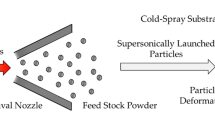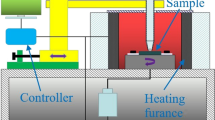Abstract
Friction surfacing (FS) enables to deposit thick coating layers with fine grain for improvement of wear and corrosion properties of the substrates. The primary flash formation inherent to the FS process occurs around the consumable rod and grows in axial direction towards the clamping zone. If this primary flash growth is axially constrained, a secondary flash starts to grow parallel to surface of the substrate. This secondary flash stays in contact with the outer surface of the coating layer, affecting the properties of FS process. The influence of secondary and primary flash formation on coating is compared in detail via SEM and EBSD concerning the metallurgical structure of the deposited layer and joining mechanisms to the substrate. In the present study, a dissimilar metal coating layer with thickness of about 1 mm is produced. The consumable rod is austenitic stainless steel AISI 316, with 10 mm in diameter, and substrate is a plate of high-strength steel (HSS). The secondary flash formation has a beneficial effect on FS process efficiency and hardness of the coating, overmatching the hardness of the HSS substrate. This fact represents opportunities for several industrial applications and a new field of research for further improvement of FS process.










Similar content being viewed by others
References
Nicholas ED (1992) Friction surfacing and linear friction welding. International SAMPE Metals and Metals Processing Conference. Simultaneous Convening of the 3rd International SAMPE Metals Conference and the 24th International SAMPE Technical Conference. Part 2 (of 2); Toronto, Ontario, Canada; 20-22 October, Code 17615. Volume 3, pp 450–463
Nicholas ED (1993) Friction surfacing. ASM Handbook, Volume 6: Welding Brazing and Soldering, Solid-State Welding, Brazing, and Soldering Processes (Chairperson: Randy Roper, EG&G Rocky Flats). ASM International. pp. 321–323
Klopstock H, Neelands AR (1941) An improved method of joining or welding metals. Application Date October 17. UK Patent GB 572789 (A). IPC B23K 20/12
Bishop E (1960) Friction welding in the Soviet Union. Welding and metal fabrication. IPC Scientific and Technology Press. Volume 28. pp. 408–410
Nicholas ED, Thomas WM (1998) A review of friction processes for aerospace applications. International Journal of Materials and Product Technology 13:45–55
Nicholas ED (2003) Friction processing technologies. Welding in the World 47:2–9
Thomas WM, Nicholas ED, Needham JC, Murch MG, Temple-Smith P, Dawes CJ (1991) Improvements relating to friction stir welding. US Patent Nº. 5460317
Rafi HK, Phanikumar G, Rao KP (2013) Corrosion resistance of friction surfaced AISI 304 stainless steel coatings. Journal of Materials Engineering and Performance 22:366–370
Dunkerton SB, Thomas WM (1986) Repair by friction welding. Repair and Reclamation, organized by Materials Engineering Committee of the Institute of Metals. The Welding Institute. Abington. September 24-25. England
Thomas WM (2009) An investigation and study into friction stir welding of ferrous-based material. PhD thesis, University of Bolton
Fukakusa K (1996) On the characteristics of the rotational contact plane—a fundamental study of friction surfacing. Welding International 10:524–529
Rafi HK, Phanikumar G, Rao KP (2011) Material flow visualization during friction surfacing. Metallurgical and Materials Transactions A 42:937–939
Vitanov VI, Voutchkov II, Bedford GM (2000) Decision support system to optimise the Frictec (friction surfacing) process. Journal of Materials Processing Technology 107:236–242
Kramer de Macedo ML, Pinheiro GA, dos Santos JF, Strohaecker TR (2010) Deposit by friction surfacing and its applications. Welding International 24:422–431
Macedo ML (2011) Caracterização de depósitos realizados pelo processo de deposição por fricção em chapas de aço de alto carbono. PhD Thesis. Universidade Federal do Rio Grande do Sul
Puli R, Janaki Ram GD (2012) Microstructures and properties of friction surfaced coatings in AISI 440C martensitic stainless steel. Surface and Coatings Technology 207:310–318
Puli R, Kumar EN, Ram GDJ (2011) Characterization of friction surfaced martensitic stainless steel (AISI 410) coatings. Transactions of The Indian Institute of Metals 64:41–45
Puli R, Janaki Ram GD (2012) Corrosion performance of AISI 316 L friction surfaced coatings. Corrosion Science 62:95–103
Govardhan D, Kumar ACS, Murti KGK, Madhusudhan Reddy G (2012) Characterization of austenitic stainless steel friction surfaced deposit over low carbon steel. Materials & Design 36:206–214
Gandra J, Miranda RM, Vilaça P (2012) Performance analysis of friction surfacing. Journal of Materials Processing Technology 212:1676–1686
Beyer M, Resende A, dos Santos JF (2003) Friction surfacing for multi-sectorial applications—FRICSURF, in, GKSS Forschungszentrum Geesthacht GmbH, Institute for Materials Research
Gandra J, Miranda RM, Vilaça P (2011) Monitoring of temperature and mechanical parameters in friction surfacing, IIW 2011 - 64th Annual Assembly, Chennai. Doc. III-1592-11
Hoseini Asliy A, Zarei-Hanzaki A (2009) Dynamic recrystallization behavior of a Fe-Cr-Ni super-austenitic stainless steel. Journal Materials Science Technology 25:603–606
Gol’dshtein MI, Bronfin BM, Shifman AZ, Osipov VV (1979) Mechanism of grain boundary strengthening of steels. Metal Science and Heat Treatment 21:104–109
Sato YS, Nelson TW, Sterling CJ (2005) Recrystallization in type 304L stainless steel during friction stirring. Acta Materialia 53:637–645
Kokawa H, Park SHC, Sato YS, Okamoto K, Hirano S, Inagaki M (2005) Microstructures in Friction Stir Welded 304 Austenitic Stainless Steel. Welding in the World 49(3/4):34–40
Saukkonen T, Aalto M, Virkkunen I, Ehrnsten U, Hänninen H (2011) Plastic Strain and Residual Stress Distributions in AISI 304 Stainless Steel Power Plant Pipe Welds. 15th International Conference on Environmental Degradation of Materials in Nuclear Power Systems and Water Reactors, TMS, August 7-11. Colorado, USA. Wiley. pp. 2351–2367
Author information
Authors and Affiliations
Corresponding author
Additional information
Doc. IIW-2463, recommended for publication by Commission III "Resistance Welding, Solid State Welding and Allied Joining Processes."
Rights and permissions
About this article
Cite this article
Vilaça, P., Hänninen, H., Saukkonen, T. et al. Differences between secondary and primary flash formation on coating of HSS with AISI 316 using friction surfacing. Weld World 58, 661–671 (2014). https://doi.org/10.1007/s40194-014-0148-5
Received:
Accepted:
Published:
Issue Date:
DOI: https://doi.org/10.1007/s40194-014-0148-5




